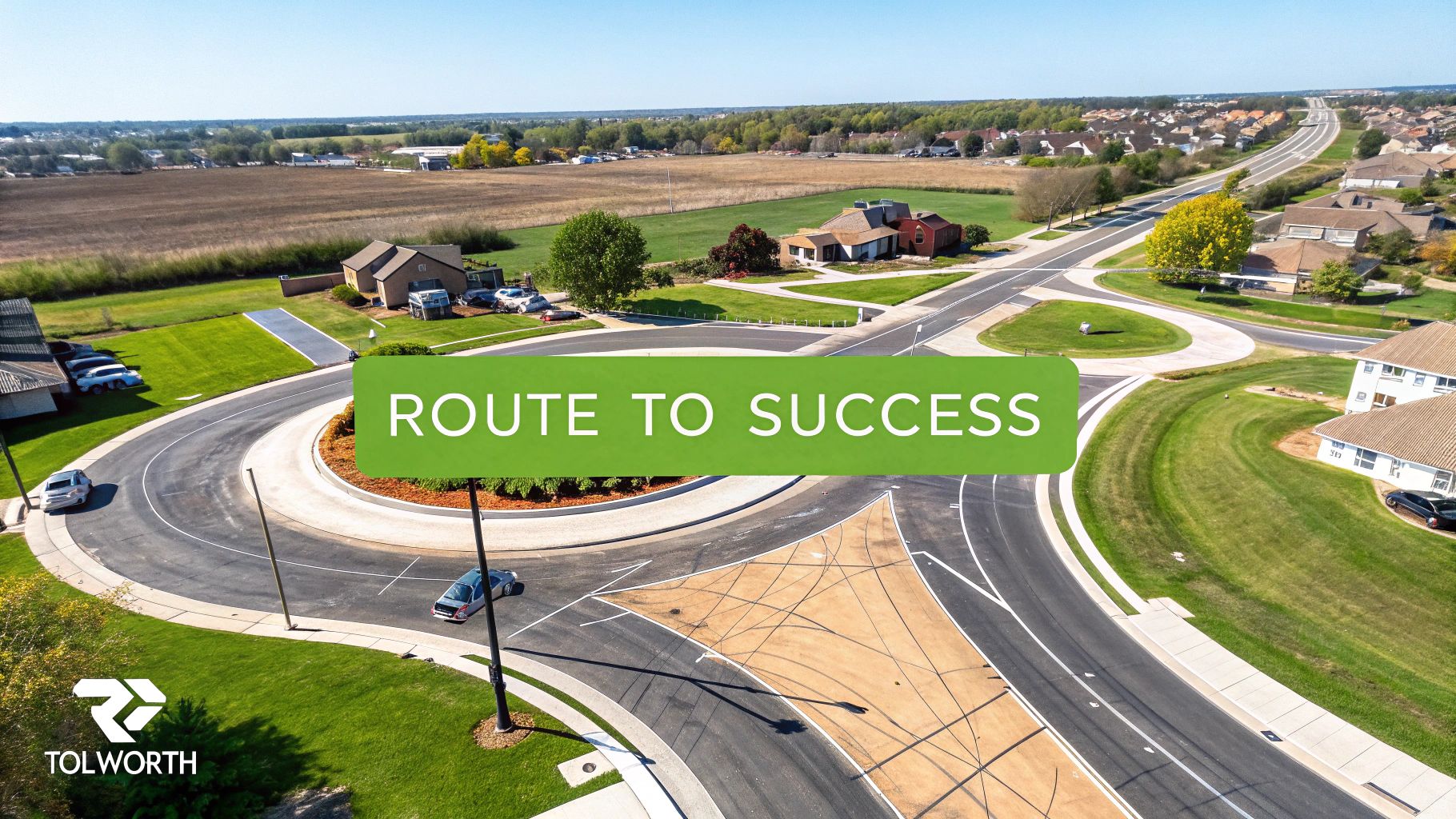The day of your practical test is creeping closer, and it's completely normal to feel a bit on edge. The best way to calm those nerves is to get prepared, and that starts with understanding the driving test routes in Tolworth. This isn't about memorising every single turn, but about getting familiar with the character of the local roads and the specific challenges you're likely to face. When you know what to expect, you can swap that anxiety for confident, focused driving.
Your Guide to the Tolworth Driving Test Centre
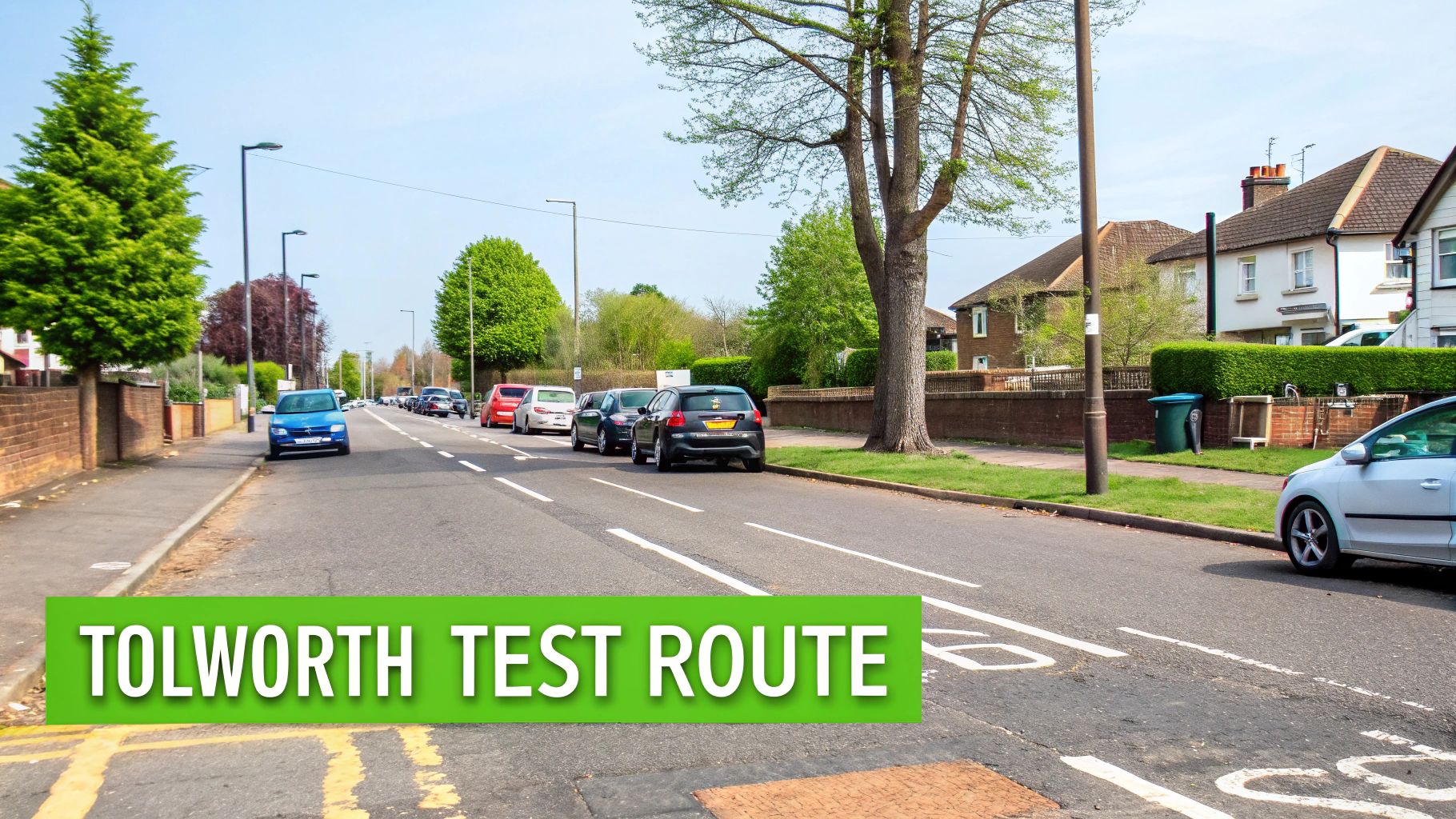
It’s easy to think of the driving test as a big, mysterious exam designed to catch you out. In reality, it's a structured check to ensure you can handle real-world driving situations safely and competently. The secret to passing isn't about getting a lucky route; it's about smart preparation.
Consider this guide your roadmap. We’ll break down the unique driving environment surrounding the Tolworth test centre, which is based at Douglas House on Douglas Road. Its location is strategic – it gives examiners quick access to an incredibly diverse mix of roads, all within a few minutes of leaving the car park.
The Tolworth Driving Environment
You can bet your test route will be a cocktail of different driving conditions. Getting a feel for these scenarios in advance helps you build a mental checklist of the skills you’ll need to have sharp on the day.
- Quiet Residential Streets: These are the examiner's go-to spots for testing your manoeuvres. They'll be watching your precision, your awareness of pedestrians (especially near schools), and how you handle tight spaces created by rows of parked cars.
- Busy Dual Carriageways: It’s almost a guarantee you’ll be taken on faster roads like the nearby A3. This is where your ability to merge correctly, get up to speed promptly, and change lanes with confidence will be closely watched.
- Complex Junctions and Roundabouts: Tolworth is notorious for some tricky junctions, with the main Tolworth Roundabout being a classic example. This is where your forward planning and ability to judge gaps in fast-moving traffic really come under the microscope.
This mix of challenges is reflected in the local pass statistics. The Tolworth Driving Test Centre has a pass rate of around 45.7%, a number that underscores just how demanding its routes can be. The rate is a direct result of the blend of quiet suburban streets, hectic urban roads, and major roundabouts that test every bit of a learner's skill set. You can learn more about the challenges at the Tolworth centre and discover how proper preparation can dramatically improve your chances.
Key Takeaway: To pass at Tolworth, you need to prove you're an adaptable driver. The examiner is looking to see if you can smoothly transition from navigating a 20 mph residential zone to confidently handling a 50 mph dual carriageway. Your ability to adjust your awareness, speed, and control for each new environment is the real test of whether you're ready for a full licence.
Decoding Common Tolworth Driving Test Routes
One of the biggest myths about the driving test is that you need to memorise exact routes. The truth is, the Driver and Vehicle Standards Agency (DVSA) stopped publishing official routes years ago to prevent exactly that. Instead, think of the test as a collection of challenges designed to see how you handle different situations.
Examiners have a 'menu' of specific roads, junctions, and manoeuvres they can pull from. While the exact combination will vary, the core ingredients are always the same. By getting to know these common sections, you'll stop worrying about which street is next and start focusing on how to drive it correctly. This section will walk you through the most likely paths you'll face on your Tolworth driving test.
Even without official maps, we know from years of experience and countless tests that certain patterns emerge. A very common route, for instance, kicks off on Douglas Road before taking you through Ewell Road, Berrylands Road, Kings Drive, Pine Gardens, Raeburn Avenue, the infamous Tolworth Broadway roundabout, and a stint on the A3. You can get a feel for how these segments connect by checking out a detailed PDF of potential Tolworth driving routes.
The image below breaks down the best way to approach learning these routes – it’s a simple, proven process.
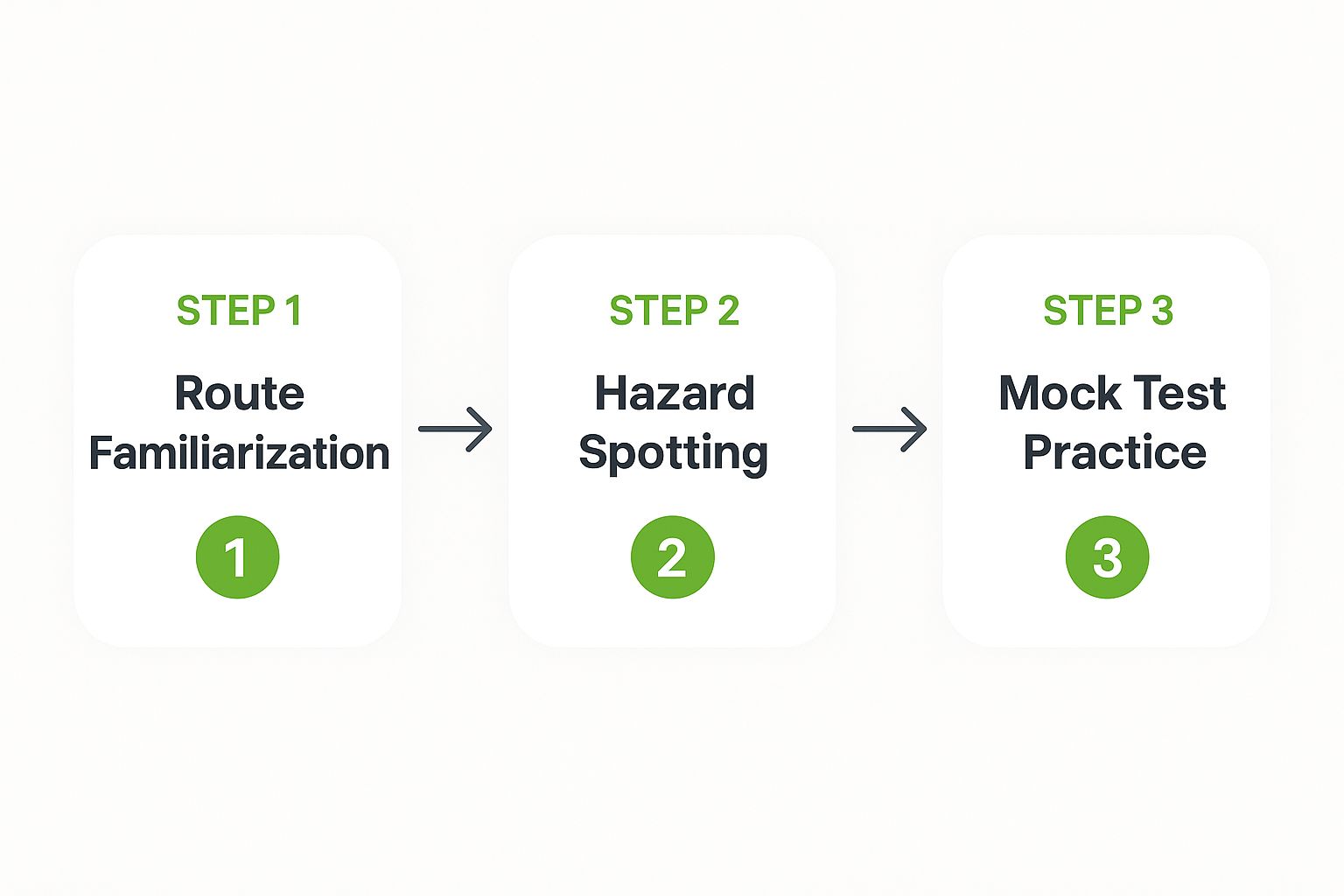
As you can see, it's a cycle. You learn the areas, practise spotting the unique hazards, and then put it all together in mock tests.
A Typical Route Unpacked
Let's break down a classic Tolworth test structure. Your examiner needs to see a complete picture of your driving skills, so nearly every test will blend three distinct environments.
-
The Residential Start: The test almost always begins on the quiet residential streets surrounding the test centre, like Douglas Road. This is where the examiner first assesses your core skills: low-speed control, clutch work, and your awareness of pedestrians and parked cars that narrow the road.
-
The Main Road Challenge: Soon enough, you'll be directed onto much busier A-roads. Get ready for key arteries like the A240 Ewell Road or even the faster-paced A3 dual carriageway. Here, the test shifts to your ability to merge into traffic, maintain appropriate speed, and stick to your lane correctly.
-
Complex Junction Navigation: Every route will feature tricky junctions, and the Tolworth Roundabout is practically a rite of passage. This is where your forward planning and ability to judge gaps in heavy, multi-lane traffic are put under the microscope. It's a real test of confidence.
What you need to realise is that examiners aren't just ticking off individual skills. They are watching how you link everything together. They want to see you transition smoothly from a quiet 20 mph road to a hectic 50 mph roundabout without a flicker of hesitation.
Example Tolworth Test Route Breakdown
To make this more concrete, the table below outlines a common route sequence, showing which skills are being tested at each stage. This helps you understand the 'why' behind the route, not just the 'where'.
| Road/Area | Key Challenge/Skill Assessed |
|---|---|
| Douglas Road & Side Streets | Low-speed control, dealing with parked cars, pedestrian awareness, and pulling away safely. |
| A240 Ewell Road | Progressing with traffic flow, hazard perception at crossroads, and dealing with bus lanes. |
| Tolworth Roundabout | Lane discipline, forward planning, judging traffic speed from multiple directions, and decisive gap selection. |
| A3 Dual Carriageway | Safely joining a high-speed road, maintaining a safe following distance, overtaking, and correct lane choice for exiting. |
| Return via Residential Area | Navigating narrower roads after being on a fast road, clutch control, and manoeuvres (e.g., parallel park). |
This breakdown shows how a single route provides a comprehensive assessment of your driving ability.
Recognising Route Patterns
Forget trying to memorise a list of street names. It’s far more effective to focus on the types of challenges that define the Tolworth driving test routes. Once you're familiar with these patterns, your confidence will soar.
Knowing that almost any route from Tolworth will include a mix of quiet streets, a big roundabout, and a stretch of dual carriageway lets you prepare mentally. Instead of being surprised, you’ll be ready. This predictive mindset is a game-changer, turning potential anxieties into scenarios you’ve already practised and are fully prepared to handle.
Getting to Grips with Tolworth's Trickiest Junctions and Roundabouts
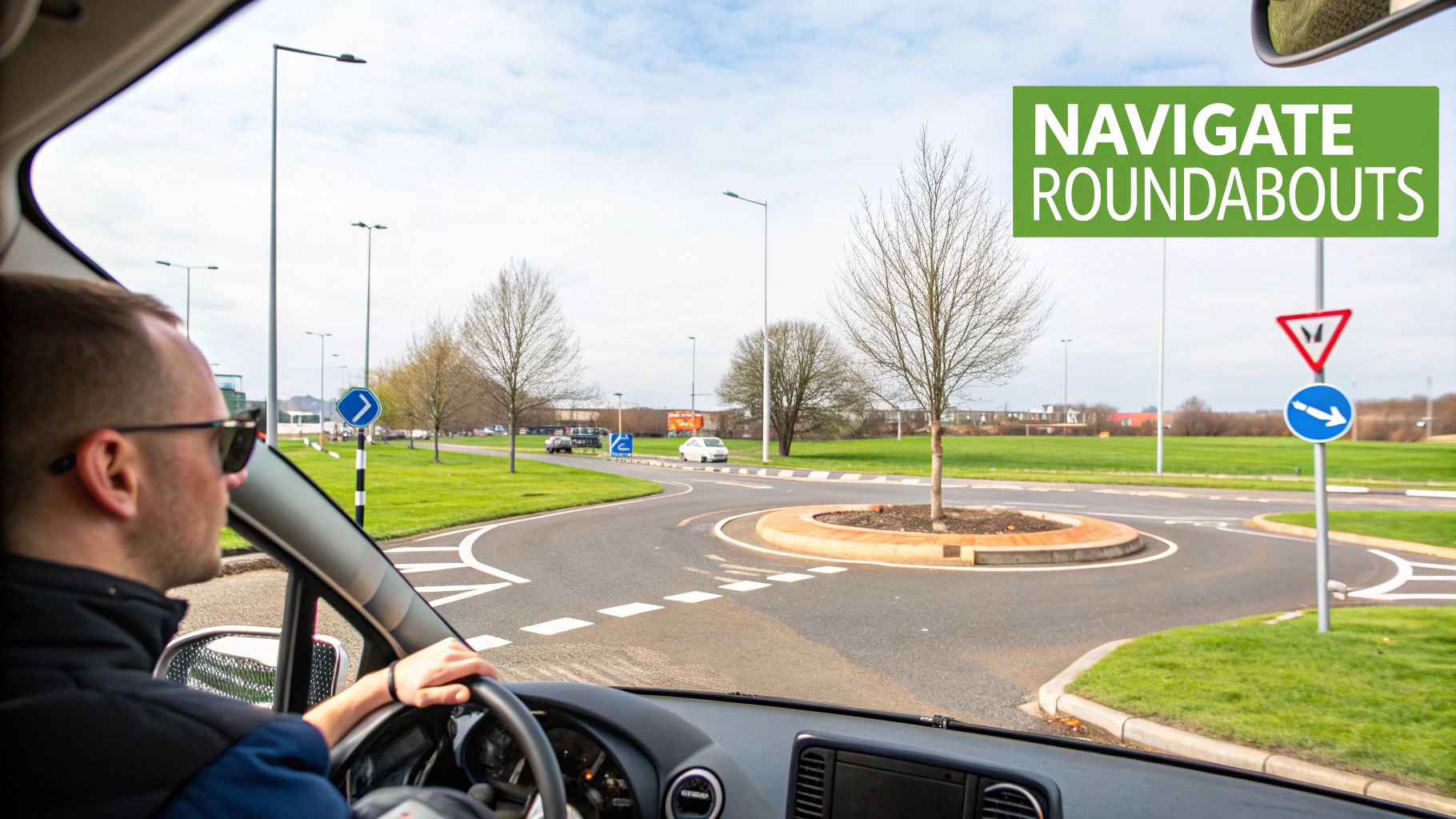
Let's be honest, certain intersections on the driving test routes in Tolworth are notorious for a reason. They're designed to separate the learners who are just going through the motions from those who can genuinely read the road ahead. Think of them less as obstacles and more as your chance to really shine.
If you can handle these spots with confidence, you're not just passing a test; you're proving to the examiner that you're a safe and competent driver. This is where we break down exactly what to expect, turning potential weak points into your strongest moments.
The Famous (or Infamous) Tolworth Roundabout
First up, the big one: the Tolworth Roundabout. It’s a huge, multi-lane spiral roundabout where major arteries like the A240 and the A3 converge. Traffic is heavy, it’s often fast, and it’s a place where indecision or poor lane discipline can quickly lead to a serious fault.
The best way to think about it is like merging onto a motorway. You can’t just edge out and hope for the best. You need to get up to speed on your approach, look far ahead, and pick your gap with confidence. It’s all about planning. Choosing the correct lane on approach is half the battle won. Get it wrong, and you’ll find yourself trying to cut across lanes, which is a definite no-go.
Remember, your examiner is looking at more than just your car's position. They're watching your eyes, seeing if you're actively scanning and planning. On the Tolworth Roundabout, that means checking far to your right for approaching traffic, judging speeds, and committing to your gap smoothly.
Your Game Plan for Complex Junctions
Beyond the main roundabout, Tolworth is peppered with other tricky junctions that demand the same core skills. Nail these principles, and you'll be well-prepared for whatever the route throws at you.
- Own Your Lane: Get into the correct lane as early as possible. Read the road signs and markings, and stick to your lane without drifting.
- Be Decisive, Not Hesitant: This is crucial. Indecision is a major red flag for examiners. Watch the flow of traffic, spot a safe and suitable gap, and go for it. Being overly timid can disrupt traffic flow just as much as being reckless.
- Master Your Observations: Your Mirror-Signal-Manoeuvre routine needs to be second nature. Constant glances in your mirrors and checks of your blind spots are essential, especially when changing lanes or leaving a roundabout.
You'll find these skills put to the test on key roads that frequently appear on test routes. The A240 Ewell Road, Hook Rise South, and Kingston Road are all common features, each with its own mix of traffic lights, lane changes, and busy junctions. Examiners love areas like the Kingston Road Junction to see how you handle merging and turning under pressure. To get a better feel for these specific challenges, you can discover more insights about these crucial roads at TestBuddy.app.
By putting these strategies into practice on the actual roads, you’ll stop seeing Tolworth’s tricky spots as something to fear. Instead, they become your stage to prove you've got what it takes to be a road-ready driver.
Mastering the Independent Driving Section
The independent driving part of your test takes up about **20 minutes**—that’s roughly half the time you’ll be behind the wheel. It’s not a test of your memory or your internal compass. Instead, this is your chance to show the examiner you can think for yourself and make safe, sensible decisions without being told what to do at every single junction.
Think of this as the moment you prove you're ready to drive on your own. On the driving test routes in Tolworth, this part of the assessment will happen in one of two ways.
Following the Sat Nav
For about 80% of tests, you'll be asked to follow directions from a sat nav. Don't worry about bringing your own; the examiner will provide the device and get it all set up for you.
Treat the sat nav like a helpful passenger, not your boss. Its role is to give you information, but your job—your only job—is to drive the car safely. Avoid staring at the screen. Listen to the voice commands and take quick, safe glances at the map, just as you would check your mirrors.
Your main focus has to be on the road ahead. Hear the instruction, like "At the next roundabout, take the second exit," and then immediately switch your brain back to driving mode: check your mirrors, signal your intention, and get into the correct position to handle the manoeuvre safely.
The biggest fear learners have about this section is taking a wrong turn. Let me put your mind at ease: you will not be failed for going the wrong way, as long as you do it safely. The examiner is checking your driving, not your navigation skills. If you miss an exit, just keep driving safely. The sat nav will recalculate, or the examiner will help you get back on track.
Following Traffic Signs
In the other 20% of tests, the examiner will ask you to follow traffic signs toward a particular place. You might hear something like, "Follow the signs for Kingston," or "I'd like you to follow the road signs for Epsom." This is designed to test how well you scan for information, plan your drive, and get into the right lane without any last-minute panic.
You'll often find this method used on the more complex driving test routes in Tolworth, particularly those involving the major A-roads and big, busy roundabouts where good sign-reading is essential.
Three Tips for Following Signs Successfully:
- Look Up and Look Ahead: Road signs are designed to be seen from a distance. Make a habit of scanning far down the road, not just staring at the bumper of the car in front.
- Plan Your Lane Early: As soon as you see the sign for your destination, figure out which lane you need. Then, make a smooth, safe move into it. Rushing to change lanes at the last second is a classic mistake.
- Match Signs to Road Markings: The signs above and the paint on the road tell the same story. If the sign shows your destination is in the right-hand lane, look for arrows on the road surface to confirm you're in the right place.
At the end of the day, it doesn't matter if you're following a screen or a sign. The examiner is looking for the exact same thing: can you take in information, plan what to do next, and keep the car under complete control? This is your moment to show them you're no longer a learner—you're an independent driver.
Spotting and Handling Common Road Hazards in Tolworth
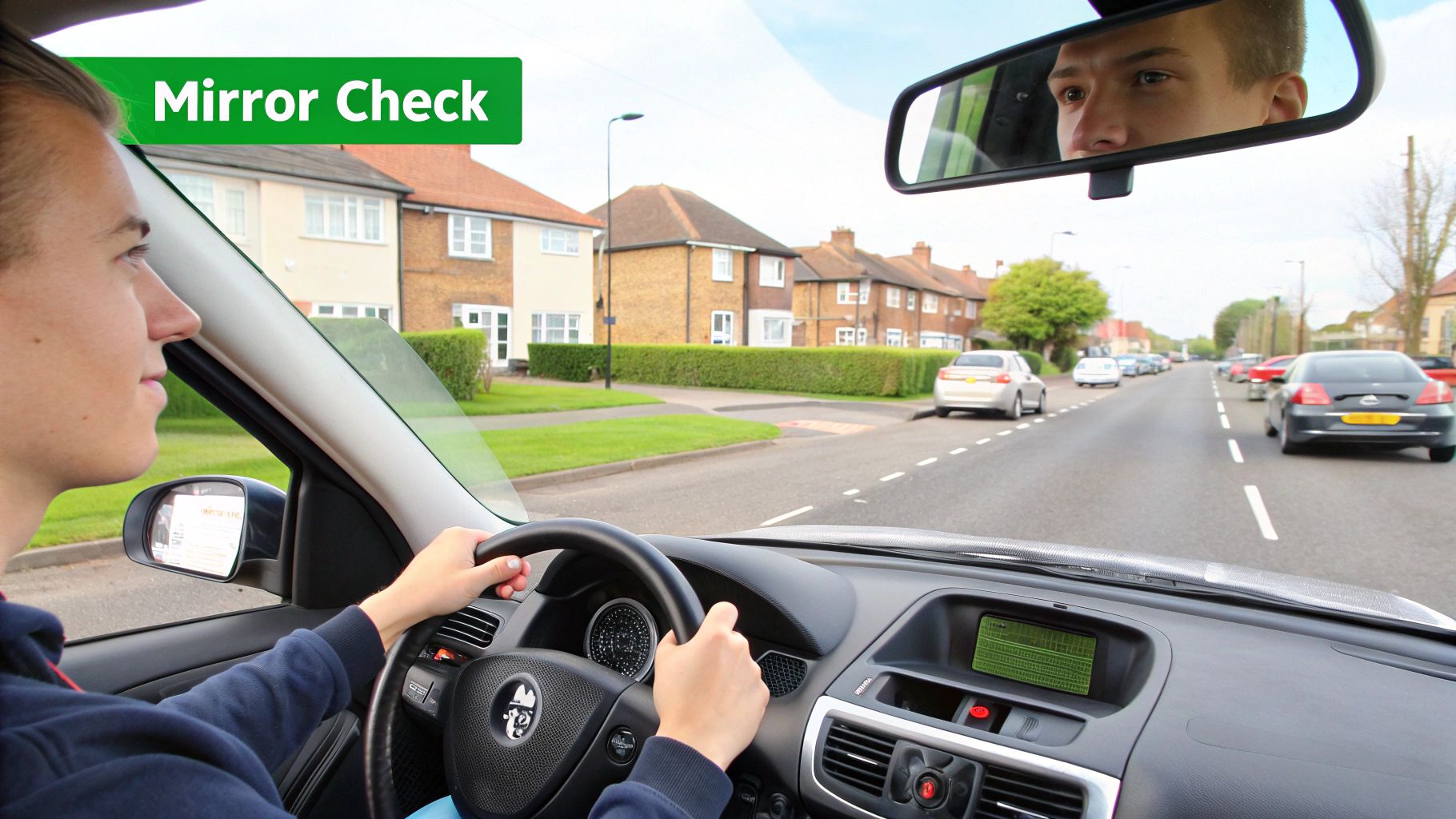
Great drivers have a knack for seeing trouble before it starts. It’s a skill called hazard perception, and it’s absolutely essential for passing your test at Tolworth. It’s not just about tackling the big, intimidating roundabouts, either. The examiner is watching closely to see how you handle the everyday stuff that can easily trip you up if you’re not switched on.
You'll find that many of the Tolworth driving test routes are designed to wind through quiet residential streets. This isn't just a sneaky way to fit in your manoeuvres. These areas present their own unique, subtle challenges that demand constant awareness and thinking ahead.
Getting Through Cluttered Residential Streets
The roads around Berrylands and close to the test centre itself are often narrow and packed with cars parked on both sides. This creates a classic hazard: a serious lack of space. It’s best to treat these streets like an obstacle course where your job is to keep a safe distance from everything and anticipate what might happen next.
A parked car is never just a parked car. It could be hiding a child ready to chase a ball into the road, or a driver could swing their door open without a second glance. The examiner needs to see that you're actively managing these risks.
- Knock Your Speed Down: First things first, slow right down. It's the simplest way to give yourself more time to spot a problem and react smoothly.
- Give Yourself Room: When it’s safe, move out towards the centre of the road. This creates a crucial safety buffer between you and the line of parked cars.
- Scan for Clues: Keep your eyes peeled for any sign of life. Can you see someone's feet underneath a car? Is there exhaust smoke? Are the brake lights on? These are all little hints that things are about to change.
Navigating these tight streets successfully tells the examiner that you're a driver who thinks ahead. They are looking for you to spot potential hazards, consider what might happen, and then adjust your speed and road position. It’s a sign of real driving maturity.
Pedestrian Crossings and Bus Lanes
Once you move away from the quiet backstreets, places like Tolworth Broadway bring a different kind of challenge. This busy high street is often swarming with shoppers, so your pedestrian awareness needs to be dialled up to the maximum. Be extra vigilant around zebra crossings and always be prepared to stop.
On top of that, many of the main roads in and around Tolworth have bus lanes. It’s up to you to know when they’re active. The hours will be displayed on blue signs, so make a point of checking them every single time. Dipping into a live bus lane during your test is a guaranteed driving fault.
By actively looking for these common hazards and showing you can manage them calmly, you're proving you're more than just a learner. You're demonstrating the awareness that makes a safe driver for life.
Your Final Test Day Preparation Checklist
So, you've put in the hours and tackled the tricky roads around the Tolworth test centre. Now, it's all about making sure the big day goes as smoothly as possible. Your preparation for the test itself starts the night before, focusing just as much on your mindset as on the practical stuff.
First things first, let's get the logistics sorted. The evening before your test, pull together everything you need. The absolute most important item is your provisional driving licence – no licence, no test. It's that simple. It's also a great time to give your car a final once-over to make sure it's up to DVSA standards. Check your tyre pressure and tread, and make sure every single light is working perfectly.
Managing Test Day Nerves
Look, it's completely normal to have butterflies before your driving test. For some people, though, that anxiety can be a much bigger deal, sometimes even turning into a genuine fear of driving (amaxophobia). The best thing you can do is acknowledge those feelings head-on; that’s the first step to getting them under control.
On the morning of the test, the last thing you want to do is rush. A calm start to the day really does set the tone. Eat a proper breakfast but maybe skip that extra-strong coffee, as too much caffeine can just make you feel more jittery. Honestly, one of the best things you can do for yourself is to get a solid night's sleep. You'll feel sharper and more rested.
A great way to start the test with a win is to know the "show me, tell me" questions inside and out. Nailing these right at the beginning is a fantastic confidence booster.
Finally, try to get to the Tolworth test centre about 10 minutes before your appointment. This gives you a bit of breathing room to find a parking spot, use the loo, and just get your head in the game without the stress of running late. By taking care of these little details, you're putting yourself in the best possible frame of mind to pass. For an even more detailed rundown, check out our comprehensive driving test checklist for a full step-by-step guide.
Your Tolworth Test Questions, Answered
It's completely normal to have a few last-minute questions buzzing around your head, even after all those hours spent practising. Let's tackle some of the most common queries about the Tolworth test to help you feel fully prepared and confident.
How Hard Is the Tolworth Test, Really?
Let’s talk numbers. The pass rate at the Tolworth test centre hovers around 45.7%. This is pretty close to the national average, but it does tell a story: Tolworth’s roads will put your skills to the test. You'll be dealing with everything from fast-paced dual carriageways and tricky roundabouts to tight residential streets.
Don't let that statistic scare you, though. Think of it as a reminder to be thoroughly prepared. Knowing the types of hazards and road layouts you'll encounter is far more valuable than trying to memorise specific routes.
What Happens If I Take a Wrong Turn?
Taking a wrong turn is one of the biggest worries for learners, but it's not an automatic fail. The examiner is testing your ability to drive safely, not your sense of direction. What truly matters is how you handle the mistake.
The golden rule is: don't panic. If you miss an instruction from the examiner or the sat nav, just keep driving safely and legally. The examiner will simply get you back on track. A sudden, unsafe swerve to correct your mistake is what will get you a fault, not the wrong turn itself.
Feeling anxious about making a mistake is a common part of the test experience. We have some great advice on how to calm driving test nerves in our dedicated guide.
What Manoeuvres Will I Be Asked to Do?
During your test at Tolworth, the examiner will ask you to perform one of these three manoeuvres:
- Parallel parking on the side of a road.
- Bay parking, which could be driving into a bay and reversing out, or the other way around.
- Pulling up on the right-hand side of the road, reversing back for about two car lengths, and then safely moving off again.
There’s also a chance you’ll be asked to do an emergency stop. Your instructor will have made sure you've practised all of these in and around the local area, so you’ll know exactly what to expect.
Ready to get on the road faster? At Fast Pass Driving Courses, we specialise in intensive courses designed to get you test-ready quickly. Find your perfect course today and pass with confidence.

